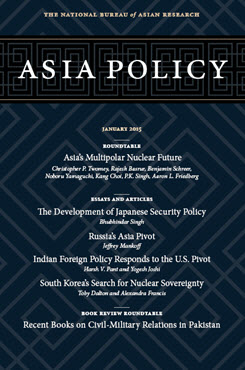The North Korean Nuclear Problem
Twenty Years of Crisis
This is one of seven essays in the roundtable “Approaching Critical Mass: Asia’s Multipolar Nuclear Future.”
Kang Choi is Vice President at the Asan Institute for Policy Studies.
This is one of seven essays in the roundtable Approaching Critical Mass: Asia’s Multipolar Nuclear Future.
The North Korean nuclear problem has gradually deteriorated in the past two decades and is becoming increasingly serious. [1] Over the course of this worsening crisis, the Democratic People’s Republic of Korea (DPRK) has staged three nuclear tests and continues to develop its diverse medium- and long-range missile capabilities. North Korea now claims to be a nuclear weapons state and has formally announced its byungjin policy, which aims for the simultaneous pursuit of nuclear weapons and economic development. [2]Pyongyang is clearly determined to develop advanced nuclear capabilities and time is running short for the international community to respond. Despite this, diplomatic initiatives aimed at denuclearizing North Korea have thus far been ineffective. Policymakers have “bought the same horse” three times by attempting, and ultimately failing, to resolve the problem through the Geneva Agreed Framework (October 1994), the September 19th agreement (September 2005), and the “leap day” agreement (February 2012). Likewise, the six-party talks aimed at peaceful denuclearization of North Korea—involving Russia, China, the DPRK, the Republic of Korea (ROK), Japan, and the United States—have in essence stalled. Considering the rate at which North Korea’s nuclear program is advancing, it is urgent that the international community adopt a more effective approach soon.
This essay explores why efforts to resolve the North Korean nuclear crisis have been unsuccessful and attempts to outline a more effective approach. The first section examines Pyongyang’s inconsistent justifications for the program, as well as its perspectives and motivations regarding denuclearization. Next, the essay assesses the obstacles hindering the international community’s efforts toward the denuclearization of North….
Endnotes
[1] For a timeline showing key developments, see “Timeline on North Korea’s Nuclear Program,” New York Times, November 20, 2014, http://www.nytimes.com/interactive/2014/11/20/world/asia/northkorea-timeline.html#/#time238_7122.
[2] For a detailed analysis on North Korea’s byungjin policy, also known as the parallel development policy, see Cheon Seong-Whun, “The Kim Jong-un Regime’s “Byungjin” (Parallel Development) Policy of Economy and Nuclear Weapons and the ‘April 1st Nuclearization Law,’ ” Korean Institute for National Unification Online Series, no. CO 13-11, April 23, 2013, http://www.kinu.or.kr/upload/neoboard/DATA01/co13-11(E).pdf.
About Asia Policy
Asia Policy is a peer-reviewed scholarly journal presenting policy-relevant academic research on the Asia-Pacific that draws clear and concise conclusions useful to today’s policymakers. Asia Policy is published quarterly in January, April, July, and October and accepts submissions on a rolling basis. Learn more


